Abstract
The article analyzes the dynamics of the labor potential development in the regions included in the Arctic zone of the Russian Federation (the Russian Arctic). This development is influenced by demographic factors due to a complex of reasons of a socio-economic and political nature. The state, structure of labor resources and labor flow of the studied regions are analyzed and compared to the all-Russian trends. Correlation, regression, and other types of analysis were performed using MS Excel software and SPSS statistical program. The analysis includes the volume, structure and dynamics of the main indicators that determine labor potential: able-bodied population, labor force, employment, unemployment, economic activity of the population, wages. A generalized assessment of the labor potential of the regions of the Russian Arctic was carried out, which allowed us to identify significant regional differences that were formed under the influence of demographic, migration and socio-economic processes. The conclusion is drawn that the integral estimate of the labor potential of all the regions of the Russian Arctic for the period 2010–2017 has decreased, compared to the increase in all-Russian indicators, which reflects negative trends in the socio-economic development of the studied regions. In the regions of the Russian Arctic, a significant imbalance has formed between demand and supply for labor resources. A set of indicators is proposed to monitor changes in the labor potential.
Keywords: Correlationinfluence of demographicmigration and socio-economic processesregression
Introduction
The study of demographic processes, as well as of any other complex phenomenon of the modern world, is characterized by the pluralism of research approaches that explain their nature and directions of development. Many researchers note the socio-economic conditionality of demographic processes. We believe that there is a relationship and interdependence between demographic processes (fertility, mortality and migration) and social mobility processes. Social mobility has quantitative indicators that are measured through the analysis of changes in economic mobility, such as changes in income, employment and unemployment (Grusky et al., 2015). In addition, the same variables, which serve as intermediate variables to assess income or wealth and which determine social inequality, affect social mobility. These include gender, race or ethnicity and age (Collins, 1993). In our opinion, the positive (negative) dynamics of demographic processes in the regions largely depends on the increase (decrease) in opportunities for social mobility. When opportunities for upward vertical social mobility are reduced, young and able-bodied people carry out horizontal mobility realizing their migration potential in other territories.
The demographic situation in the North of Russia is largely determined by migration than fertility and mortality. The desire of people to get education, higher income, and to find a job that matches their qualifications make them migrate to developed regions and countries with a higher standard of living.
Labor potential along with natural resources, financial and productive capital is the basis of a modern market economy. This is an important indicator of economic development at the regional, national and global levels (Sushko, 2014; Sokolova, 2016; Yarasheva, 2018). In the context of transition to innovative economic development, labor resources are the basis for the formation of regional and national income. Increasing labor potential is the most urgent task for the Arctic regions of Russia due to the negative dynamics of demographic processes and the growth of population migration from the northern territories.
The degree of theoretical elaboration of the research topic
The degree of theoretical elaboration of the topic of human capital and labor resources is high, but some aspects are not sufficiently studied and require updating. In economic theory, human capital is considered a broader concept (Deming, 2017; Magomedov, 2001). The theory of human capital was developed by many famous world scientists such as Becker, Schulz, Kuznets, Solow, Lucas and others. The concept of labor resources, first formulated by academician Strumilin in 1922, became narrower: it represents population capable of working, i.e. employed and unemployed. Foreign scientists often use a different concept – human resources. Since the 1970s the concept of “labor potential” has become the subject of study and discussion in various fields of knowledge. A major contribution to the theoretical understanding of the category of “labor potential” was made by Russian scientists Pankratov, Kolosova, Andreeva and others. The theory of labor potential, described in the works of numerous researchers is not completely formed. We support the scientists who consider the concept to be a generalizing, integral socio-economic category, including qualitative and quantitative characteristics of labor (Kapitsin, 2018). The “labor potential” category should be separated from the categories of “labor resources” and “human capital”, which are the basic components of the process of formation of labor potential.
Thus, to identify opportunities for human participation in the economy, the concepts of human capital and labor resources are used. If we consider labor resources together with the abilities of workers and the conditions for their implementation, which depend on quantitative and qualitative factors, it is useful to stick to a broad concept of labor potential, which can be considered a resource category.
With the development of the theory, the methods for assessing labor potential improved from calculating natural indicators to cost ones, on the basis of which balances were put up. The natural approach is based on the analysis of statistical data taking into account the volume of labor resources. The cost approach is based on the assessment of indicators of wages, gross regional product, etc. To evaluate dynamic indicators and make forecasts, a new method (an index method) has been formed (Simonova et al., 2018), which consists in calculating relative indicators of labor potential. Currently, scientists are developing a system of indicators of labor potential and calculations by result methods (Bobylev & Grigoriev, 2017).
Problem Statement
Nine regions of the Arctic zone of the Russian Federation (the Russian Arctic) were allocated as the research objects. The boundaries of the land territories of the Russian Arctic were determined by the Decree of the President of the Russian Federation dated May 2, 2014. The Russian Arctic includes the entire territory of four constituent entities of the Russian Federation (Murmansk Oblast, Nenets Autonomous Okrug, Chukotka Autonomous Okrug and Yamalo-Nenets Autonomous Okrug) and partly the territories of Arkhangelsk Oblast, Krasnoyarsk Krai, and Sakha Republic (Yakutia) (since 2017, three municipalities of the Republic of Karelia). Due to the fact that the statistic database of demographic processes is poorly represented at the level of municipalities that are part of the Russian Arctic, and the demographic processes themselves are interdependent with the policies of the center and regions, as well as the socio-economic situation in them, we have taken nine Arctic entities together as the unit of analysis.
The purpose of the article is to study the changes in the labor potential of the regions of the Russian Arctic, occurring under the influence of demographic factors due to a complex of reasons of a socio-economic and political nature.
The natural and migratory population movement in the northern regions of Russia is an object of interdisciplinary research by demographers Fauzer et al. (2018); Sinitsa (2016); Simonova et al. (2018), economists Korovkin et al. (2015), sociologists Osipova & Maklashova (2016). Attention of Russian researchers is gradually shifting from studying the territories of the Far North of Russia to the Arctic regions. In the foreign monograph by Orttung (2017), one of the sections is devoted to the impact of migration on the sustainable development of cities in the Russian Arctic (Orttung, 2017), since the Russian Arctic is a highly urbanized region, in which the problem of single-industry towns has become severely aggravated.
The analysis of English-language sources shows that a relatively small number of works are devoted to the study of demographic processes in the Arctic regions of Russia. In them, population migration is considered as an integral part of demographic processes, along with fertility and mortality factors (Karabchuk et al., 2017). Depopulation processes in the North of Russia were studied in detail in the works of Heleniak (2009). A number of works present regional features of migration in the Russian Arctic (Andrienko & Guriev, 2002; Dudaev et al., 2013).
Research Questions
Due to the negative dynamics of natural population growth and migration outflow, the total population of the regions of the Russian Arctic for the period 1989–2017 decreased by more than 27%. The largest population losses occurred in 1989–2000, when the total population decline was 20% (Table
The population decline over the eighteen-year period in the regions of the Russian Arctic by 2018 amounted to about 14 %. The most significant decrease in the population of the regions of the Russian Arctic was due to the mechanical outflow of residents (91 %). The natural population decline over eighteen years amounted to 110.6 thousand people (9 % of the total population decline). Only three regions recorded a natural population growth by 2018: Yamalo-Nenets Autonomous Okrug, Sakha Republic, Chukotka Autonomous Okrug. Mechanical decline due to migration outflow from 1999 to the present is observed in all regions of the Russian Arctic. The largest population decline is observed in Chukotka Autonomous Okrug (40 %), Komi Republic (26 %), Arkhangelsk Oblast (21 %), and the Republic of Karelia (19 %). Against the background of a general decline in the population in the regions of the Russian Arctic, only Yamalo-Nenets Autonomous Okrug has had population growth (+ 5.7 %).
Migration outflow is one of the key factors for population decline. Along with migration outflow, the Russian Arctic is characterized by high migration activity of the population due to shift work.
Purpose of the Study
Migration has a significant impact on the quantitative and qualitative characteristics of the labor resources of countries and regions, as the human capital moves with migrants. Migration processes can lead to a reduction in labor resources and human capital in the regions losing population, and to its increase in the regions with population growth.
To determine a generalized assessment of labor potential, it is useful to use the experience of applying the methodology for calculating the human development index, which has been used in Russia since 1998. A general assessment of labor potential is carried out with the determination of the main indicators that make up the potential and the calculation of their chain indices. We have chosen the following main indicators: the volume of labor force, number of employed population, and average monthly wages. Other unidirectional indicators can be included in the calculation, which will increase the accuracy of the integral estimate of labor potential. The indices were calculated using the chain method, as the ratio of the relevant indicators in the reporting period to the previous one. Next, the geometric mean value was calculated, which allowed maintaining the product of the individual values of a given value unchanged, provided an account of the dynamics of the indicators, and was often used in the analysis of the growth rates of the indicators:
(1)
Where I is the integral estimate of labor potential, is the chain growth rate, n is the number of indicators used in the calculation of the integral estimate.
The integral estimate of labor potential allows analyzing selected indicators for different periods of time, identifying regional problems and formulating tasks to solve them.
Research Methods
The works of foreign and Russian scientists in the field of population demography made up the methodological basis of the study. To assess the state, structure and dynamics of the population, methods of comparative statistical and sociological analysis were used. The spatial method is associated with the understanding of space as a natural human environment. This method allows exploring the interaction of territorial regulators with natural, political, legal and cultural ones (Kapitsin, 2018). The study used quantitative methods of statistics, census materials and qualitative methods of sociological research, the development index of Russian regions, the Human Development Index. The use of qualitative methods made it possible to study the triggering and attractive factors of population migration, to analyze the migration attitudes of the population in the regions of the Russian Arctic. For our study, the analysis of the factors determining the demographic processes (natural and mechanical population decline, aging) and labor potential is important.
To confirm the general trends and differences in the labor flow, we conducted the analysis of the state and the structure of labor resources and labor flow in the Arctic regions of Russia, as well as the comparative analysis with similar indicators for Russia from 2000 (for some indicators from 2005) to the present. Correlation, regression, and other analyses were performed using the data analysis tools of the MS Excel software and SPSS statistical program. The analysis includes the volume, structure and dynamics of the main indicators that determine labor potential: able-bodied population, labor force, employment, unemployment, economic activity of the population, wages. To study the labor potential, the information of the Ministry of Labor and Social Protection and the data of the Federal State Statistics Service (FSSS) were used, which applies the methodology for determining labor performance indicators recommended by the 19th International Conference of Labor Statisticians. The results obtained made it possible to make a general assessment of the labor potential of the Arctic regions of Russia and formulate proposals to increase the efficiency of its use.
Findings
We applied the index methodology to compare the Arctic regions by the level of development of human capital. The Human Development Index (HDI) is the most universal tool for comparing countries and regions in terms of the level and quality of life and the development of human capital. The HDI is calculated as a system of three indicators: longevity (calculated on the basis of average life expectancy), education (based on the percentage of literate population and students) and standard of living, through gross national income (GNI) per capita at purchasing power parity. A significant drawback of the HDI is that the index does not take into account the loss of regional human capital due to population migration. To analyze the regions of Russia, the old calculation method was used, which had been applied until 2010. For Russia, the HDI indicator made up 0.875 in 2015. According to the HDI, all regions of Russia can be divided into four groups. The first group includes highly developed regions (financial and economic centers such as Moscow (0.949) and St. Petersburg (0.942) and commodity export-oriented ones such as Komi Republic, Nenets Autonomous Okrug, Yamalo-Nenets Autonomous Okrug, Sakha Republic. The second group consists of developed regions (with reliance on the manufacturing and mining industries such as Arkhangelsk Oblast, Krasnoyarsk Krai, and Murmansk Oblast). The third group is medium-developed regions (industrial-agricultural ones such as the Republic of Karelia). The fourth group is represented by the less developed regions (Chukotka Autonomous Okrug). (Table
Most of the Arctic regions have improved and have high rates of human development. Nenets Autonomous Okrug, Yamalo-Nenets Autonomous Okrug and Sakha Republic (Yakutia) are among the top ten of 85 Russian regions. In fact, the Arctic regions, possessing high human capital, but not providing their population with high-quality living conditions, act as migrant donors for other regions of Russia, primarily for large centers. The population outflow, primarily young people and people with higher and vocational secondary education, not only worsens the demographic situation in the northern regions, but also reduces the chances of innovative development of the Arctic regions.
The analysis of the dynamics of the working age population in the Arctic regions and Russia as a whole has shown a general negative trend over the past ten years (Figure
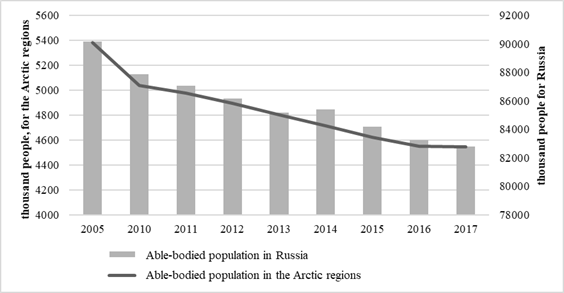
Another important difference between the Arctic regions and the all-Russian trend is the decrease in the labor force over the period from 2000 to 2017. (Figure
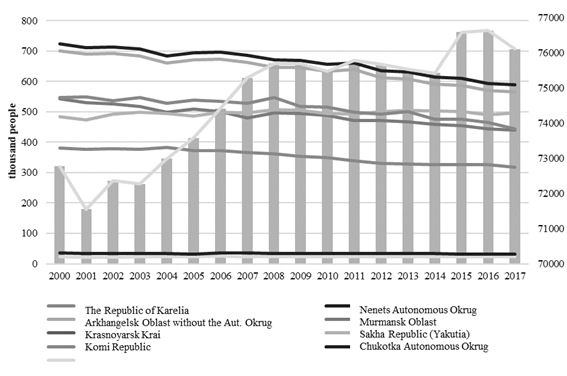
Against the background of the positive trend in the dynamics of population employment in Russia observed since 2000 with an increase of 11 % to the level of 2017, employment in the five Arctic regions showed a decrease from 4 to 14 % (Figure
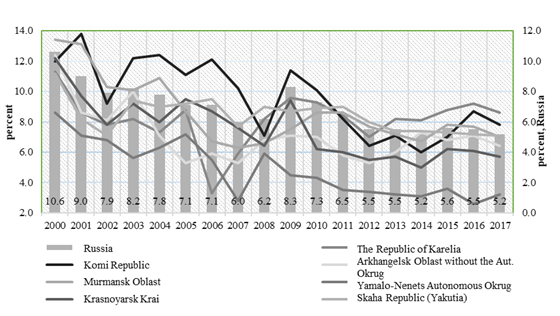
Prospects for the development of the labor market in the Arctic macroregion depend on an effective socio-economic policy, as stated in the Concept of State Migration Policy of the Russian Federation for the period 2019–2025, which affects the supply and demand of labor, the price of labor and allows maintaining a decent living standard. The indicators of the living standard include the level of wages and disposable gross income of the population. The dynamics of the average monthly nominal wage in the Arctic regions and Russian regions since 2005 shows a positive trend (Figure
Thus, in the regions of the Russian Arctic, there is an imbalance between supply and demand for labor resources in general and for highly qualified personnel in particular. The lack of demand for high-level specialists indicates a low level of innovative development of the macroregion. The excess of highly qualified personnel naturally leads to their migration outflow. In this situation, two scenarios for the development of the Russian Arctic are possible. The first one is the gradual desolation of the macroregion with isolated settlements of shift workers. This trend has clearly emerged and is manifested in a population decline. The second scenario is currently not obvious. It implies a radical change in the state policy of the Russian Federation in the Arctic towards ensuring sustained innovative development and technological breakthrough, which will save the existing human potential.
Summarizing the results of the analysis of the labor potential of the Arctic regions, it should be noted that their indicators are lower in comparison with the all-Russian ones (Figure
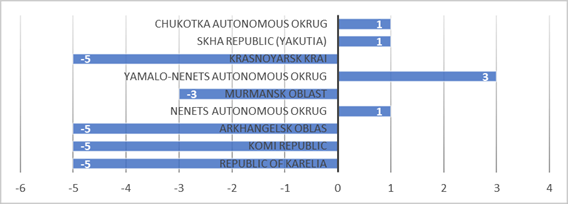
We conducted a generalized assessment of the labor potential of the regions of the Russian Arctic (Figure
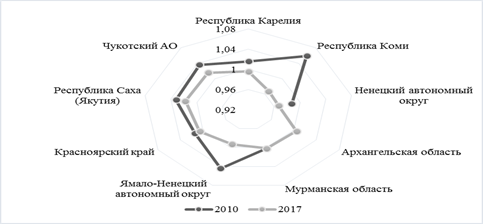
The integral estimate in 2010 showed (Figure
Conclusion
In the regions of the Russian Arctic, previously prevailing positive demographic dynamics at the end of the 20th century changed to the opposite one. The economic and technocratic approach, which has dominated the practice of public administration since the beginning of the 1990s, has had a negative impact on the demographic situation in the Arctic regions, which is reflected both in the natural population decline and in permanent negative migration balance in most regions of the Russian Arctic. The consequence of the sharp change in state priorities has been a decrease in the motivation for work and life in the North for highly qualified personnel and youth. As a result, in the Arctic regions, human and labor potential accumulated during the 20th century turned out to be undemanded. With the exception of individual regions, migration outflow caused by a cardinal transformation of state policy in favor of Arctic exploration on a rotational basis is the dominant demographic trend of the 21st century.
Most of the Arctic regions possessing high human capital, but not providing their population with high-quality living conditions, act as donors of migrants – carriers of human capital – for other regions of Russia, primarily for large centers. More than half of those who left the Arctic in 2008-2017 are people with higher, incomplete higher and vocational secondary education. The largest quantitative losses of people with higher and vocational secondary education among the Arctic regions are in Komi Republic, Arkhangelsk Oblast and Murmansk Oblast. The main factor contributing to the outflow of the youth is low demand in the labor market of the Arctic regions. The labor market in the Russian Arctic is characterized by an imbalance between demand and supply of labor resources. The lack of demand for highly qualified specialists in the labor markets of the regions of the Russian Arctic indicates a low level of innovative development of the macroregion.
The analytical assessment of the demographic indicators and the labor potential of the Arctic regions showed that overcoming negative demographic processes requires the development of a large-scale long-term development program for the Russian Arctic. It is important that the program provides measures to reduce large-scale labor migration flows from the Arctic territories. The following measures are necessary:
an increase in the number of jobs through the development of all sectors of the economy, launch of new enterprises and the development of existing business entities;
support for enterprises implementing social and infrastructural policies by providing benefits, loans, etc.;
integrated infrastructure development of territories;
intensification of scientific and innovative projects, which will help increase the number of jobs and improve the living standards of the population as a whole;
increase in budget expenditures for social security and implementation of housing programs to support families.
Thus, the labor potential of the Arctic regions is developing under the influence of many economic and social factors. At present, migration flows and the balance of labor resources have negative indicators, which is also confirmed by the calculations of the integral estimate of the labor potential of the regions of the Russian Arctic. Small production volumes and low profitability, low investment attractiveness of the regions, low supply on the labor market, small budgets of the regions and lack of funding for social infrastructure cause a migration outflow from the Arctic regions.
Acknowledgments
The work was performed at the Department of Bauman Moscow state technical University.
References
- Andrienko, Y., & Guriev, S. (2002). Determinants of Interregional Mobility in Russia: Evidence from Panel Data. CEFIR Working Paper, 10.
- Bobylev, S. N., & Grigoriev, L. M. (2017). The report of human development in the Russian Federation in 2017. Moscow: Analytical center of Government of Russ. Fed.
- Collins, P. H. (1993). Toward a New Vision: Race, Class, and Gender as Categories of Analysis and Connection. Race, Sex & Class, 1(1), 25–45.
- Deming, D. (2017). The Growing Importance of Social Skills in the Labor Market. The Quarterly J. of Econ., 132(4), 1593–1640.
- Dudaev, A. A., Chupakhin, V. S., & Oland, J. (2013). Health and Society in Chukotka: An Overview. Int. J. of Circumpolar Health.
- Fauzer, V. V., Lytkina, T. S., & Smirnov, A. V. (2018). Sustainable development of the northern regions: population dimension. Econ. of the reg., 14(4), 1370–1382.
- Grusky, D., Smeeding, T., & Snipp, M. (2015). A new infrastructure for monitoring social mobility in the United States. Annals, 657, 63–82.
- Heleniak, T. (2009). The Role of Attachment to Place in Migration Decisions of the Population of the Russian North. Polar Geography, 32(1-2), 31–60.
- Kapitsin, V. M. (2018). Regulators of Migration adaptation (Issues of Methodology and Classification). Russ. J. of legal studies, 1, 158–166.
- Karabchuk, T., Kumo, K., & Selezneva, E. (2017). Demography of Russia: From the Past to the Present. Palgrave Macmillan.
- Korovkin, A. G., Dolgova, I. N., Edinak, E. A., & Korolev, I. B. (2015). Estimates of current and future development of labour force and migration relations of Russian Arctic’s regions. Modernizat. Innovat. Res., 6(4-1), 213–222.
- Magomedov, M. M. (2001). Labor potential in the socio-economic development strategy (regional case). Report of D. Sc. Thesis. Moscow.
- Orttung, R. (2017). Sustaining Russia’s Arctic cities: resource politics, migration, and climate change. Berghahn Publ.
- Osipova, O. V., & Maklashova, E. G. (2016). Migration intentions of the Arctic youth in the context of subjective evaluation of social wellbeing. Arctic and North, 24, 14–26.
- Simonova, M., Kolesnikov, S., & Karakova, T. (2018). Assessment of labor potential on the regional level by the index method. MATEC Web of Conferences, 170, 01069.
- Sinitsa, A. L. (2016). Demographic development of extreme north regions and equivalent areas in 2000–2015: migration results. Vest. of Surgut State Univer., 2(12), 53–57.
- Sokolova, F. K. (2016). Migration processes in the Russian Arctic. Arctic and North, 25, 158–172.
- Sushko, O. P. (2014). Labor potential of the Russian Arctic. Arctic and North, 16, 72–83.
- Yarasheva, А. V. (2018). Regional economic problems: labor potential of the Far East development. Sci. bull. of the Southern Instit. of Manag., 3(23), 32–37.
Copyright information

This work is licensed under a Creative Commons Attribution-NonCommercial-NoDerivatives 4.0 International License.
About this article
Publication Date
27 February 2021
Article Doi
eBook ISBN
978-1-80296-101-0
Publisher
European Publisher
Volume
102
Print ISBN (optional)
-
Edition Number
1st Edition
Pages
1-1235
Subjects
National interest, national identity, national security, public organizations, linguocultural identity, linguistic worldview
Cite this article as:
Sushko, O., & Plastinin, A. (2021). The Labor Potential Of The Regions Of The Russian Arctic. In I. Savchenko (Ed.), National Interest, National Identity and National Security, vol 102. European Proceedings of Social and Behavioural Sciences (pp. 992-1003). European Publisher. https://doi.org/10.15405/epsbs.2021.02.02.123

